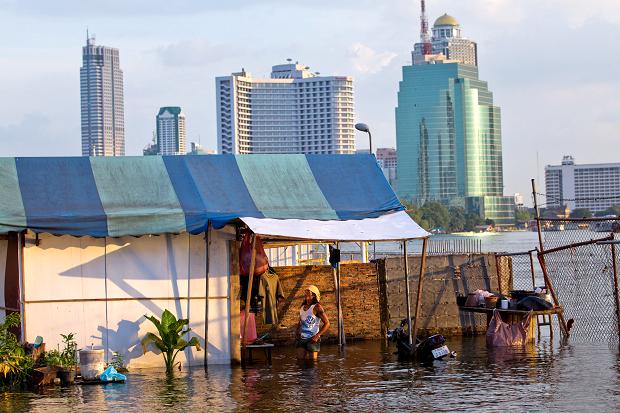| | International 
[ 2011-10-28 ] 

The floods are seeping into central Bangkok along the Chao Phraya river Thousands flee flooded Thai capital
Thousands crowded on to buses, trains and flights
out of Bangkok yesterday after the Government
urged people in low-lying areas to flee as rising
flood-waters threaten to swamp the city.
The floods, caused by almost a month of heavy
rain, have already overwhelmed outlying northern
areas and are seeping into central Bangkok along
the banks of the Chao Phraya river. At high tide
yesterday, ankle-deep water briefly reached the
Grand Palace, the former residence of Thailand’s
kings.
Foreign governments, including the British,
advised against all but essential travel to
Bangkok and other flooded provinces in the centre
and north of the country. A five-day public
holiday has been declared in the affected areas
until next Tuesday, and the country’s Flood
Relief Operations Centre encouraged those who
could, to leave the city.
“I would like to ask Bangkok people who are
already affected or could be affected soon to
consider evacuating to other places,” said
Thongthong Chantarangsu, a spokesman for the
organisation, which has been criticised for
offering contradictory advice.
Yingluck Shinawatra, the Prime Minister, who has
also been criticised for her response, said: “It
seems like we are fighting against the forces of
nature; massive floodwater that is causing damage
to several of our dykes. What we can do now is to
manage it, so that it flows slowly, otherwise
everybody will suffer.”
More than 370 people have died in the north and
centre of the country, where the waters have left
electricity power lines exposed, and even
liberated crocodiles from flooded reptile farms.
Ms Yingluck has warned that it could be weeks
before the waters recede. In Bangkok, the flooding
is expected to reach a climax tomorrow evening,
when an unusually high tide will surge up the Chao
Phraya to meet the waters flowing down. The fear
is that the river will burst its elevated banks,
flooding the centre of the city which so far has
remained unaffected.
“We expect floodwater to remain in Bangkok for
around two weeks to one month,” Ms Yingluck
said. “The situation shouldn’t be as serious
as in other provinces. We shouldn’t face water
as high as two or three metres staying for two or
three months as we’ve seen in other
provinces.”
Some Bangkok supermarkets are rationing staple
goods such as rice, eggs and toilet paper, and
others are running short of bottled water, after a
deterioration in the quality of tap water. Many in
apartment buildings, offices and shops have
barricaded entrances with sandbags. Sukhumphand
Paribatra, the city governor, said that 90 per
cent of the northern district of Don Muang was
under water yesterday, including most of the
city’s second, domestic airport where the flood
relief body has made its headquarters, and where
1,500 refugees from flooded areas north of Bangkok
have taken temporary shelter.
Suvarnabhumi, the main international airport, was
operating normally yesterday, but there were long
queues of passengers, many of them affluent
residents fleeing the city.
Buses and trains were busy on routes heading
south, and many hotels in the tourist beach
resorts of Hua Hin, Phuket and Pattaya were full
of those fleeing from Bangkok.
The British Foreign and Commonwealth Office is
advising against non-essential travel to Bangkok
and the 26 provinces affected, although it
emphasises that those arriving at Suvarnabhumi
airport in transit to other parts of Thailand need
not change their plans. “The flooding is likely
to disrupt transport, close tourist attractions
and may affect electricity and water supplies,”
a travel advisory says.
“Supply chain disruption and high demand is
causing shortages and cash machines may not work
in flooded locations . . . British nationals
already in Thailand should exercise caution and
follow the advice of local authorities if the area
that they are in is flooded.”
Fifty thousand Thai troops are on stand-by to help
with evacuations, as well as 1,000 boats and 1,000
military vehicles. Evacuation centres are being
established in eight provinces for as many as
200,000 people.
Beyond the damage caused by the water, the floods
are expected to damage the tourist industry, which
employs more than two million people. The
Government estimates that up to a million visitors
could be scared away.
Source - The Times(UK)

... go Back | |




